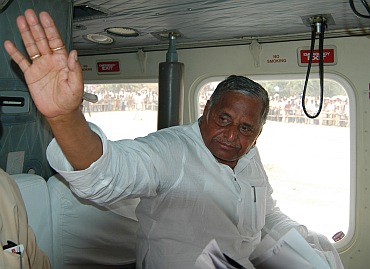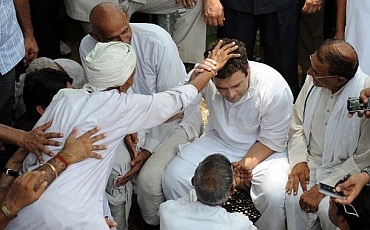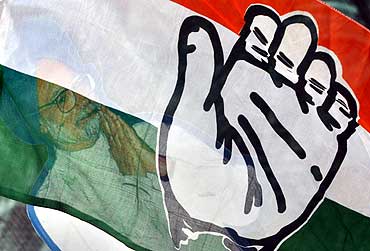
On Sunday, Rashtiya Lok Dal chief Ajit Singh, who was sworn in as Union Cabinet Minister, was allocated the civil aviation ministry. And the next move of the Congress, in the run up to the Uttar Pradesh elections, is to grant reservations to Jats in the central list of Other Backward Classes. Neerja Chowdhury analyses
Now that it has the Congress-Rashtiya Lok Dal tie-up under its belt and Chaudhary Ajit Singh has been sworn in as Union minister, the United Progressive Alliance government is getting ready to grant reservations to Jats in the central list of Other Backward Classes, and the announcement is expected in the next days.
The government had already announced its intent to include backward Muslims in the Mandal list at the Centre, which provides 27 per cent reservations to the OBCs. The idea is to help consolidate the Jats and Muslims behind the Congress-RLD alliance, which is expected to have a bearing on 60-70 seats, most of them in western Uttar Pradesh, which the alliance sees as its main catchment area. The reservation to Jats-Muslims move may annoy the Yadavs but that is a group unlikely to vote for the Congress.
Finally, with the crossing of the 't' s and the dotting of the 'i' s, the Congress has decided to leave 45 seats for the RLD in the assembly elections, which has formally joined the United Progressive Alliance, while this alliance takes the UPA tally in Lok Sabha up to a more comfortable number 277, from the razer thin 272.
When the late PM Vishwanath Pratap Singh had opted to implement the Mandal Commission's decision in August 1990, the late socialist leader Madhu Limaye had repeatedly urged him to include Jats in the list. Limaye had argued that had Singh listened to him, it would have saved the Janata Dal government, forcing Jat leaders like Devi Lal and Ajit Singh to fall in line.
Click on NEXT to read further...

And now, the wheel has come full circle as the decision -- to give reservation in government jobs to Jats in the OBC list -- is about to be implemented. But then a lot of water has flowed down the Yamuna since 1990. "Mandal" has been accepted by all parties, and Jats are part of the OBC list in states like Rajasthan (given by the Bharatiya Janata Party government) and in UP.
It is widely conceded that UP is ready for a change. The Congress-RLD tie-up is meant to create a "hawa" that the Grand Old Party of India is not such a write-off as being projected. It is early days yet to make predictions but the Congress and the RLD leaders would like to believe that their alliance has "opened up the game", even though the campaigning is yet to start.
In what is expected to be the mother of all elections, the question under discussion is how much will it help the Congress party. It will certainly enhance the RLD tally. For alliances have helped Ajit Singh in the past, but he has not been able to transfer his vote to other parties -- like Mayawati is able to do -- and the BJP had discovered this to its cost. The Ajit camp of course is quick to rebut this by counter-arguing that had that been the case, the BJP would not have been able to win Ghaziabad, Meerut and Agra in 2009.
Even if the Jats, who comprise eight per cent of the 22 districts that they want carved out as Harit Pradesh, vote for Ajit Singh but may not transfer their vote to the Congress candidate unless he too happens to be a Jat, the Congress has reasons to smile. The Jats will plump for the Congress, where a Jat is not likely to win.
More important, the Brahmins in western UP may look at the Congress afresh. They had been inclined towards the Congress in the 2009 elections but, of late, were beginning to turn away, given the plethora of scams that have hit UPA II. They were beginning to view the BJP as a possibility. But if they realise the Congress party, backed by Jats and Muslims, has a chance to win, they may go back to it.

In any case, the alliance will help charge the atmosphere in western UP and create an overall impression that the Congress has something in its kitty. Certainly the alliance is expected to weaken Mulayam's party in western UP, particularly if the Muslims start to look elsewhere.
It is early days to make predictions, but the Congress-Ajit camp hopes "to win 80-100 seats" in the forthcoming assembly polls.
Seats apart, what is critical for the party is not so much the number of seats it wins, though it would have to up its tally to make a respectable showing. What will make a difference is if the party is able to form a government in Lucknow along with the Samajwadi Party and the RLD. If this happens, and the Congress is also able to wrest Punjab and Uttarakhand from the National Democratic Alliance, it will help the party turn around a difficult situation it faces nationally.

Rahul Gandhi has staked his personal prestige in UP and some have faulted him for his "naivete" in jumping in when it is clearly such an uphill task.
The Congress focus is threefold. It is into Maya-bashing for her failure on the development and governance fronts, and Rahul Gandhi is taking her on for the "elephant devouring" all the money sent by Delhi to Lucknow. Side by side, he is trying to establish his credentials in being able to deliver -- he delivered the Bundelkhand package, after his repeated visits to the area; he is ensuring that there are amendments in the land acquisition law, now on the anvil, after his visit to Bhatta Parsaul, and this may find resonance amongst farmers in 15-20 districts; he has come out with a package for the weavers of eastern UP after his visit to aranasi. He is making the point that he is delivering concretely -- and will continue to do so in the future.
The party's campaign plan is not without the underpinnings of caste equations. It is working on the Muslim-Kurmi combination, which could find traction in 70-80 seats. This is not to say that just because Beni Prasad Verma is with the Congress and a Union minister, all the Kurmis would automatically swing to the Congress. But a section may do so, as they did in 2009.
It goes without saying that the party would have been better placed to go for the kill, had Rahul Gandhi got into the act earlier, and started doing what he is doing today at least eight months earlier.
Whether or not it will work, the Congress has decided to play the reservation card. Besides granting reservation to Jats and Muslims in the central OBC list, it would like to provide 50 per cent reservations to SCs, STs and OBCs in the envisaged nine-member Lok Pal body -- something all parties seem to agree on.

The Anna Hazare agitation against corruption, with opposition parties piggybacking on him, particularly the BJP, is reminiscent of the politics of VP Singh during the 1987-89 period when the Bofors issue of corruption had angered the urban middle class. But Singh knew that it was not enough to win an election. He used to say at the time that despite the euphoria he had generated, he had no chance of dethroning Rajiv Gandhi, with his 415 Lok Sabha seats, till Rajiv made the mistake of going in for "Shilanyas" for the Ram temple in 1989, under pressure, and consequently the Muslims began to move away from him.
VP Singh played the Mandal card in the hope of forming a different political axis, made up of OBCs, Muslims and Dalits, and though it neither saved his National Front government nor brought him to power again, it brought about a paradigm shift in Indian politics. It threw up leaders like Mulayam Singh Yadav, Laloo Yadav, Nitish Kumar, and even helped Mayawati, and they have not looked back.
Today, the Congress has no choice but to play the post-Mandal politics of VP Singh and forge the same, or similar, alliance (OBC, Dalit, tribal, Muslim) to counter the Hazare following of the urban middle classes, who had voted for the Congress in 2004 and 2009 but who have now deserted the party.
The tie-up with RLD, reservation to Jats and Muslims, and quota in the Lok Pal body are moves though still tentative ones, in that direction. The trouble is that the Congress agenda does not have a face so far.
